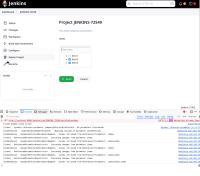-
Type:
Bug
-
Resolution: Fixed
-
Priority:
Major
-
Component/s: active-choices-plugin
We are not able to create an active choice parameter in jenkins pipeline job after upgrading the Jenkins even though it is giving it as an option in parameter dropdown.
Current Jenkins Version: Jenkins 2.426.1
Active Choice plugin version: 2.6.4
- is blocked by
-
JENKINS-71909 active choice updates in wrong order (does not Cascade the values correctly)
-
- Closed
-
